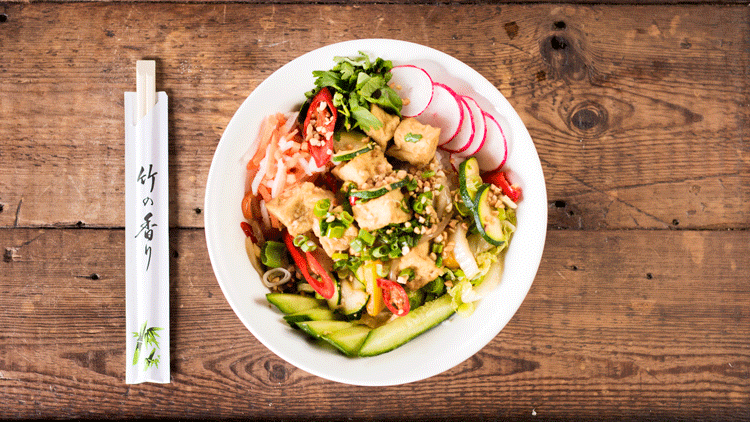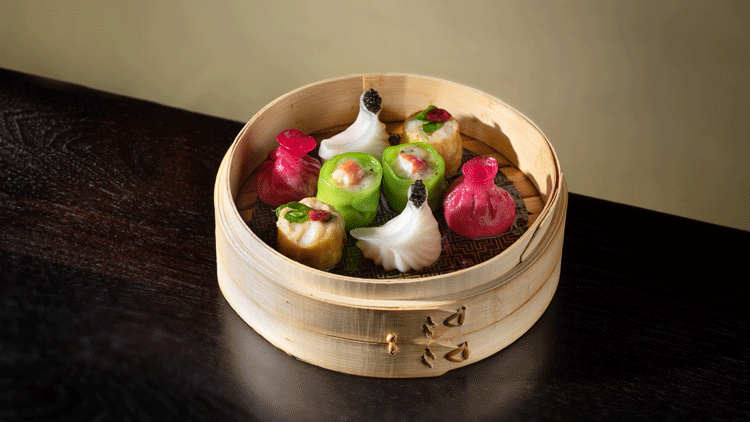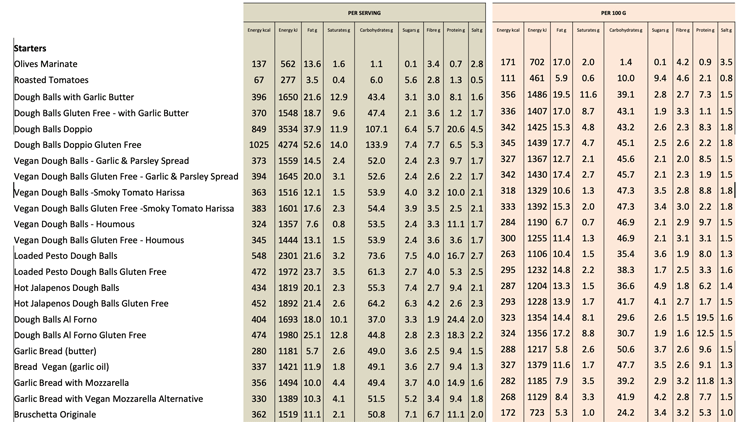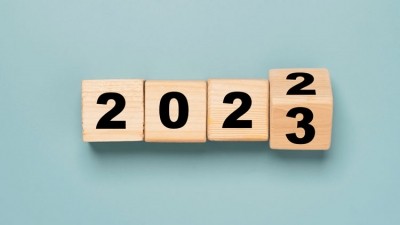Read it and weep: Mandatory calorie labelling arrives
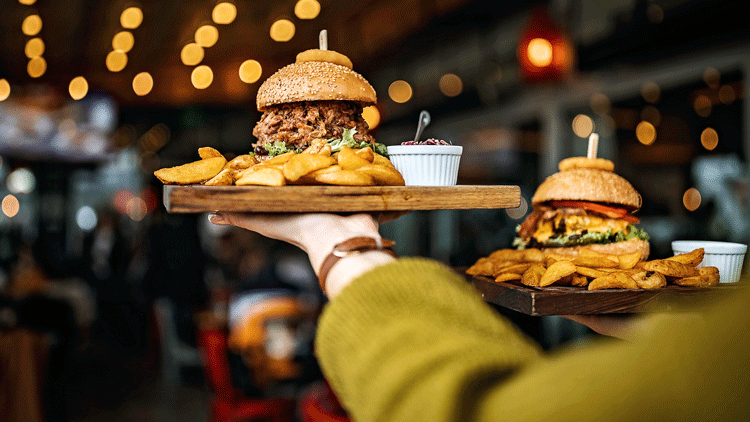
Nobody has ever asked at Galvin at Windows. It’s never come up at a Hawksmoor. It’s not even been broached at Hakkasan, and that’s been going for more than 20 years. In fact, as far as those in charge know, not a single customer in any of these restaurants has ever enquired about calories.
Yet in just a few days the information will be staring all their guests in the face as mandatory calorie labelling for out-of-home comes into force in England.
Under the rules businesses that employ 250 or more staff must display calorie counts ‘clearly and prominently’ at the point of choice – typically a menu – along with the statement that ‘adults need around 2,000 kcal a day’. Non-alcoholic drinks must be calorie counted if they aren’t served in or alongside their original packaging but – rather bafflingly, it must be said - anything over 1.2% abv is exempt.
Few in the industry are happy about mandatory calorie labelling as a concept and are even less pleased with the Government’s timing. So bad is it that trade body UK Hospitality has even gone as far as saying that the legislation threatens to derail the sector’s recovery from the pandemic.
The industry’s biggest bugbear is the cost of implementation, with the analysis of dishes time consuming and expensive, as is the redesigning and reprinting of menus. Though few are willing to voice it, there is also a worry that customers will be put off ordering certain dishes when faced with their calorific value or, worse still, be deterred from eating out more generally.
An inconvenient truth
Calorie counts lay bare an inconvenient truth about most restaurant food. Often, the reason it tastes better than eating at home is that chefs have a freer hand with delicious things like butter, olive oil and cheese.
Alongside all this is a widely held view that calories are an unsophisticated way of getting people to think about making healthier food choices. As Hawksmoor co-founder Will Beckett points out, a bowl of All Bran with a banana and natural yoghurt has roughly the same number of calories as a McDonald’s Hamburger.
Hakkasan agrees that calories are a blunt tool. “What the calorie content doesn’t portray is the nutritional value, so we’re looking at calories as a negative, yet our bodies require them as fuel. By solely looking at calorie content we’re not taking into consideration the goodness the food also provides,” says Alix Pickard, director of marketing at the top-end Chinese restaurant business’ parent company Tao Group.
And it's not just those in the industry that have an issue with calories being the be-all and end-all when it comes to nutrition. Nutritionist Rhiannon Lambert views the 2000 kcals as outdated. "What these figures do not take into account are people’s age, their size, or their physical activity levels, which can greatly influence the amount of calories a person consumes in a day."
"Also, you may not absorb the full amount of energy (i.e. the calories) or nutrients that is released from foods that are shown on the packaging, due to individual differences such as your gut health and intestine length or how much of the nutrients you absorb. Use the numbers if you wish as a tool but know it is not the ultimate answer to defining nutrition and health," says Lambert, who is currently working with national Vietnamese restaurant group Pho.
In sharp contrast to other industry gripes like VAT, business rates, and staffing, the issue surrounding calories is not something many business leaders want to talk about. So reluctant are they that many chefs and restaurateurs approached for this feature politely declined to comment, and of those that did most were unable (or unwilling) to reveal the calorie counts of their menus.
“The industry is doing this with great reluctance. Operators regard it as unnecessary. They are irritated by it,” says MW Eat CEO Ranjit Mathrani, who sits on the board of UK Hospitality and was part of what is said to have been quite a tense series of negotiations with Government.
That said, there is a grudging acknowledgement from some groups that calories are a useful way of identifying menu dishes that most customers perceive as ‘healthy’ aren’t necessarily the best choice for those watching their waist. The classic example of this is dressed salads, which are often one of the most calorific things on a casual dining menu.
Healthy option: a tofu rice bowl at Pho
Counting calories (and heads)
While the new rules apply to groups that employ more than 250 people it’s not as clear cut as just working out a business’ headcount. It makes no difference whether staff are full or part time, but they must be directly contracted, meaning that people on zero hours contracts still count, but not casual or seasonal workers.
The Government’s guidance is clear that franchised businesses can’t get out of it if a particular franchisee happens to have fewer than 250 employers. But the situation is less clear for restaurant groups that operate lots of different formats. D&D London , for example, which operates a mix of casual dining and fine dining restaurants across the country is – grudgingly, it is understood - having to rollout calorie counts across its estate but JKS Restaurants, which operates a similar model, is confident that it won’t need to because its various restaurant brands are registered as their own companies with their own PAYE.
It’s also understood that the top-end of Gordon Ramsay’s UK estate - including his three-star flagship Restaurant Gordon Ramsay - won’t have to put calorie counts on menus because they’re all under different limited companies. The situation is similar at Jason Atherton’s The Social Company group, with the high-profile chef taking the view that his restaurants are all different entities despite being under the same umbrella.
UK Hospitality - which has produced a useful piece of guidance on calorie labelling - is in the process of seeking legal clarification on how a qualifying business is defined.
Mathrani’s MW Eat has also avoided it because its fine dining arm - which includes the likes of Chutney Mary and Veeraswamy - and its more casual Masala Zone chain are under different limited companies.
He believes that the new rules will be particularly difficult to implement for medium-sized hospitality business with 250 up to around 1,000 staff. “At that sort of size, they won’t necessarily have the right structures in place to absorb the costs,” he says. “Huge companies such as McDonald’s and KFC have nutritionist on their payroll. Implementation will also be more challenging for less standardised businesses that cook from scratch.”
The restaurant group run by brothers Chris and Jeff Galvin is a good illustration of the scattergun nature of the legislation. Most of their restaurants won’t have to do it as the company employs fewer than 250 staff, but their two hotel restaurants – Galvin at Windows at the Hilton Park Lane and Galvin Bar & Grill at the Kimpton Fitzroy London Hotel – will because the teams there are employed by large hotel groups.
“It’s yet another layer,” says Chris Galvin. “We’re getting to the point where keeping track of things like health and safety, allergens and now this is one person’s job. It’s a salary and yet another cost that’s going to have to go onto each plate of food.”
Caught in the crossfire
It is likely that higher-end, special-occasion places weren’t the target of the legislation, yet many have found themselves caught up in it. This is especially true of restaurants in large hotels. The F&B department of The Ritz, for example, employs far fewer than 250 staff but the hotel overall employs over 250, meaning that executive chef John Williams will have to put calories on all his menus. With calorie-heavy dishes such as foie gras terrine and beef Wellington mainstays of the classic French restaurant, this is unlikely to be a move the hotel will approve of.
The Langham is in the same situation, with the hotel in the process of calorie counting every one of the central London hotel’s menus, not least its afternoon tea. “Let’s face it, an afternoon tea is all about indulgence,” says hotel manager Nick Davies. “It’s not the sort of thing somebody is going to eat every day. But we’ve got to do it and we’re going to do it properly.”
Even with this rigorous approach, Davies, in common with nearly all his peers, is unwilling to talk specific numbers. Yet given that some three-course meals at PizzaExpress – which already calorie counts its food – come close to 2,000 calories, it’s safe to say that an indulgent experience involving scones, jam and clotted cream at a London hotel is going to be a similar number. When it comes to tasting menus, many guests will be looking at figures that exceed 2,000.
Higher-end restaurants that change their menu regularly may be able to partly circumnavigate the legislation by taking advantage of an exemption clause for items that are on the menu temporarily, which is defined as fewer than 30 days a year. It would be entirely possible for a creative, seasonally driven restaurant to ensure that no one dish was on the menu for more than a month each year, especially if only a small tweak – for example changing the vegetable garnish or sauce – was required for it to be considered distinct from that which had come before it.
Chris Galvin welcomes the flexibility this aspect of the legislation offers, but he will still be putting calories on menus in nearly all cases. “A lot of ingredients come and go. We’re very seasonal. If Marc (Hardiman, the head chef at Galvin at Windows) needs to substitute something at the last minute it gives us some leeway. But in the main we’ll be taking a belt and braces approach to this.”
Unsurprisingly, nobody is willing to go on record saying they will use the 30-day rule to duck the legislation, but John Wood, founder of software solution company for the hospitality sector Kitchen Cut suspects some will give it a go. “There are certainly people out there that are looking for loopholes. There are also people that are rolling the dice by waiting to see how it goes and what the enforcement is like.”
Indulgent: afternoon teas are likely to chalk up big numbers
Crunching the numbers
So how does a restaurant go about calorie counting a dish? The process starts by establishing exactly what’s in it, something restaurants should already have a handle on following the Government’s shake up of allergen rules in 2014. What might be less familiar for some, though, is identifying not only what’s in the dish but exactly how much of it.
The next step is to establish how calorific each ingredient is per gram. Most suppliers will be able to supply detailed nutritional information including calories per 100g for all the lines they sell but some suppliers - particularly smaller, artisanal ones - don't provide nutritional information (unlike allergens, there is no requirement for them to do so).
Any blanks must be filled in using a database, such as the Government-approved McCance and Widdowson’s The Composition of Foods. Armed with this information chefs could theoretically work out calorie counts for each dish with just a calculator, but most will use specialist software that pulls everything together such as Kitchen Cut or Fourth’s Recipe and Menu Engineering tool.
“We’re the lucky ones as we have support from big companies like Hilton,” says Galvin. “But I feel for chefs without big resources. To be completely accurate is difficult. We’re not scientists and we’re not running a production line. And our ingredients change. Animals grow differently – at some times of the year they take on more fat, at other times of year they are leaner.”
To account for this, the legislation grants a tolerance of 20% either side. “That’s a sensible number,” says Wood. “Ingredients aren’t always the same. And we’re dealing with chefs. Sometimes they’re going to use more and sometimes they’re going to use less.”
Getting technical
The tolerance will also help account for cooking processes to some extent. Though oddly not mentioned in the Government’s guidance, how an ingredient is cooked and the changes it undergoes in the cooking process can make a big difference to its final calorie value. For example, deep-fried food will take on a certain amount of oil while pasta will lose starch (carbohydrates) to the water as it cooks.
Information is available to help account for these processes, but there is another option for restaurants that want to be even more exacting. Labs can analyse the exact number of calories in a plate of food using a number of different processes (one sees the dish dehydrated before being set on fire in order to measure the energy it produces).
A recent arrival to the UK, Japanese udon chain Marugame Udon has sent off the entirety of its menu to be assessed in this manner (it has shown calorie counts on menus since it launched last year). This approach makes a lot of sense for large brands with core menus that rarely change but is unworkable for restaurants that change their menus with any regularity, not least because it costs around £50 to analyse a single dish.
Full steam ahead: Hakkasan is well-positioned to balance indulgent options with healthier ones
No surprises
For most, the calorie counting exercise has yielded few surprises. “While we may not have known the exact calorie content, we do know in detail the ingredients and cooking processes, which give us strong insight into which dishes are higher or lower in calorie content,” says Hakkasan’s Pickard. “What may surprise our guests is that there is a wide range of dishes that they could enjoy whilst not exceeding their daily allowance.”
Rosa’s Thai operations director Tom Cousins is also of the view that the cooking method and ingredients within a dish gives operator a strong indication of where they are going to be calorie wise. “Pad Thai is a wok-fried noodle dish seasoned with a big dollop of palm sugar. We always knew that one was going to be on the high side,” says Cousins, who can’t quite bring himself to reveal the calorie count of his group’s best-selling dish.
Whitehall may well be pleased to note that the process of getting menus calorie counted is already influencing dish development in some groups. BigHospitality understands that a well-known burger chain was forced to completely overhaul its vegan burger when it clocked in at a staggering 2,000 calories (with fries).
“Some dishes were a bit frightening if I’m being honest,” says Galvin of his food. “It’s been a useful exercise to get us thinking about using things that are less rich. But we don’t use butter and cream like we used to. Over the past 15 years we’ve probably halved the amount of butter we get through each week.”
National French brasserie chain Côte has taken into account calories with its ‘evolved’ menu that was launched late last month. Created by former Gordon Ramsay chef Steve Allen, the menu comprises 38% of main dishes that contain fewer than 700 calories. The company says there will also always be several options to allow diners to choose a two-course or three-course meal totalling 1,000 calories or fewer. It will also be offering unlabelled menus, on request, to those who prefer not to see calorie information (this is permitted under the legislation so long as menus with calorie counts on them are offered by default).
Rosa’s Thai’s Cousins says that findings may see some recipes revised ahead of Rosa’s Thai twice-yearly menu changes. “It’s also made us think about introducing more lighter dishes to offset some of the higher calorie items. But the driving force here will always be authentic recipes and delicious Thai food. We will only tweak if we can do so without compromising on taste.”
Hawksmoor’s Beckett admits that the exercise saw the team scan menus for ‘headline generators’. “By and large we just want to comply with the legislation and continue trying to do the best job we can for the people who come to eat in Hawksmoor.”
The PM’s Damascene moment
Government intervention in this area has been on the horizon for some time. In 2010 David Cameron’s Government pressured larger groups to make calorie information available (to those that wanted to see, at least) saying at the time that if they didn’t legislation would follow.
This light-touch approach resulted in the majority of national restaurant chains and the big fast food players providing the information, with some even opting to put it on menus (most notably McDonald’s). Mission accomplished? Apparently not.
In 2018, amid spiralling obesity rates, Theresa May’s Government announced that it wanted to do more to “encourage the public to make healthier food choices” and a public consultation into out-of-home calorie labelling was launched.
The project appeared to lose momentum, likely due to a change at the top, with May replaced by Boris Johnson soon after the consultation closed. But then Covid-19 struck. The data – and the Prime Minister’s own experience of being hooked up to a ventilator – showed that excess weight put people at greater risk of serious illness or death from the virus. Within just a few months of Johnson leaving hospital, the legislation was pushed through.
Big on the internet: Most larger restaurant brand's have offered calorie information online for some time
Who’s counting?
Local authorities will enforce the legislation, but the enforcement and sanction regime will be different to food safety because the stakes aren’t nearly as high: miscalculating the calories in a knickerbocker glory is unlikely to cause anyone any serious harm, whereas dirty kitchens and poor cross-contamination controls have the potential to kill.
Local authorities are likely to hand responsibility for enforcement over to their existing food safety teams rather than set up new departments. While inspectors could theoretically pack food up and send it to a laboratory, the most likely approach will be an assessment of the methods a restaurant is using to analyse its dishes as well as checking to see that information is being presented to the customer in an appropriate way.
While each council will take a slightly different approach to enforcement, central Government is understood to have mandated a supportive, educational approach in the first instance. Those that aren’t complying will be issued with an improvement notice. If that is ignored, businesses can expect a fine of £2,500. Repeated flouting of the rules could lead to a criminal prosecution, but the Government expects such cases to be rare.
Changing ordering habits
The industry knows roughly what to expect when it comes to the process of getting menus calorie counted and enforcement. What’s less clear is to what degree it will affect what guests order. Mathrani believes that few of his peers are that worried about major shifts in ordering habits with the possible exception of businesses that have a core product that is highly calorific.
Hakkasan, for one, isn’t overly concerned. “Some demographics come to our restaurants to enjoy lighter dishes accompanied by pots of tea, and are health conscious so make considered choices,” says Pickard.
“Many come to us for a treat or a special occasion, and the dishes they order are chosen because they are delicious and not the kind of food they would eat every day, therefore they prioritise flavour and experience over calorie content. Bearing that in mind, the addition of calories shouldn’t drastically change their behaviour.”
Hawksmoor’s Beckett points to studies in the US that suggest restaurants don’t have too much to worry about. “Reviews of the efficacy of the legislation looked like it could be summarised as: people might change their habits at first, but there’s no big lasting impact.”
But some do think calorie counts could have a big impact on what guests order. “It’s a big change. It’s going to be staring people in the face whether they want people to see it or not,” says Rosa Thai’s Cousins.
The Langham’s Nick Davies agrees that calories will cause some guests to rethink what they order. “I’m just not sure how many.”
Who's counting? The basics of the legislation
When does the legislation come in?
6 April 2022.
Who does it apply to?
Businesses with 250 or more employees, where food or drink is prepared in a way that means it is ‘ready for immediate consumption by the person who buys it’.
Is anything exempt?
Temporary items that are on the menu for less than 30 days (AKA ‘specials’) are exempt from the requirement. Pre-packed food and drink not made on site, drinks over 1.2% ABV and condiments don’t need to be calorie counted either.
What information needs to be shown?
Businesses must display the energy content of the food in kilocalories (kcal) and reference the portion size to which the calorie information relates (where applicable).
Where must the information be shown?
At the ‘point of choice’ for customers, typically a printed menu but also buffet displays and online menus. Wherever the information appears, it must be accompanied by the statement that ‘adults need around 2,000 kcal a day’.
How can calories be calculated?
The guidance says that calorie counts can be based on manufacturers analysis; calculation from known or average values in ingredients; and calculation from generally accepted data sets. Though not mentioned in the guidance, calculating calories by sending dishes to a laboratory is presumably also allowed. Businesses are permitted a 20% either way to account for changes in ingredients or cooking processes.
How will the legislation be enforced?
By local authorities. Compliance with the new regulations can be included as part of other enforcement activities including food safety, traceability, and labelling requirements. Local authorities have discretion in how they enforce the regulations, including how the accuracy of calorie information is assessed.
What are the penalties for non-compliance?
Businesses that fail to comply will be given an improvement notice. If businesses don’t implement what is required, they may be hit with a civil sanction of £2,500 as an alternative to criminal prosecution. Those who continue to flout the rules could eventually face a criminal prosecution, but the Government expects such cases to be rare.
